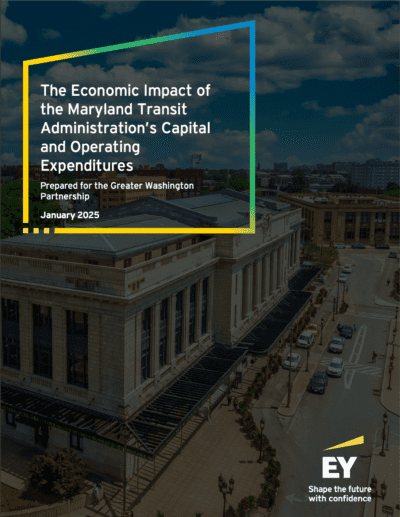The Economic Impact of the Maryland Transit Administration’s Capital and Operating Expenditures
Publish Date: January 2025

 Download Report »
Download Report »
Greater Washington Partnership engaged EY to prepare an analysis of the economic impact of the Maryland Transit Administration (MTA). MTA has significant statewide impacts on jobs, GDP, and economic output directly and indirectly supported by MTA. The economic impacts of MTA’s yearly capital expenditure and operations costs outweigh upfront costs – investing in public transit continues to provide a wide range of positive impacts to the statewide economy, not just where service is most robust.
The study details the estimated impact of MTA’s capital and operating expenditures. Capital costs include state of good repair, Locally Operated Transit Services (LOTS), the Purple Line, and other capital expenditures. For more detailed impacts on the proposed Baltimore Red Line Light Rail project, read the report from Baltimore’s Transit Future (co-led by Greater Washington Partnership) released in November 2024. Operating expenditures include bus, rail, administration, and other expenditures. Total impacts from these figures are presented at the state and regional levels (Baltimore City, Baltimore Region, and Non-Baltimore Region).
MTA’s average annual capital expenditures over the last five years (FY20-FY24) was $580 million, $410 million (71%) of which was estimated to be spent within the state and supported economic activity in Maryland. The spending is estimated to have supported $610 million of economic output and 2,920 average jobs over the five-year period. The direct operating expenditures for FY24 was $1.1 billion, $920 million (81%) of which is estimated to have occurred within the state of Maryland. This spending supported approximately $2.0 billion of economic output and 6,130 jobs in the state.